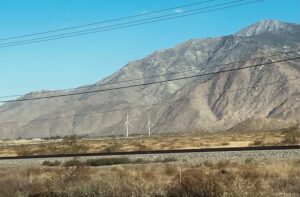 Nestled within the Mojave Desert of Nevada, Red Rock Canyon is a geological wonderland known for its stunning rock formations. This article will explore the captivating features of Red Rock Canyon. With a focus on the Calico Hills, the Keystone Thrust Fault, the spires, arches, and canyons sculpted from sandstone. As well as the unique aesthetic and escarpments created by this ancient rock.
Nestled within the Mojave Desert of Nevada, Red Rock Canyon is a geological wonderland known for its stunning rock formations. This article will explore the captivating features of Red Rock Canyon. With a focus on the Calico Hills, the Keystone Thrust Fault, the spires, arches, and canyons sculpted from sandstone. As well as the unique aesthetic and escarpments created by this ancient rock.
The Calico Hills in Red Rock Canyon
One of the most iconic features of Red Rock Canyon is the Calico Hills. These vibrant, multicolored sandstone formations are a visual treat, displaying shades of red, orange, yellow, and white. The Calico Hills owe their distinctive hues to the presence of iron oxide and minerals in the sandstone. These formations, shaped by millions of years of erosion, create a breathtaking backdrop against the desert landscape.
The Keystone Thrust Fault
The Keystone Thrust Fault is another geological marvel found in Red Rock Canyon. This fault line, formed 65 million years ago, is responsible for the unique layering of rock formations in the area. The Keystone Thrust Fault occurs when older rocks are push over younger rocks. Thus resulting in a dramatic displacement of the Earth’s crust. This tectonic activity has given rise to the awe-inspiring cliffs and slopes seen throughout the canyon.
Spires, Arches, and Canyons Made from Sandstone
Red Rock Canyon is home to a variety of rock formations, including spires, arches, and canyons. Which all are sculpted from the sandstone that dominates the region. The sandstone, composed of compacted sand grains, offers a malleable canvas for the forces of nature to shape. Therefore over millions of years, wind and water have carved out intricate patterns. Further resulting in the creation of arches, narrow canyons, and towering spires that seem to defy gravity.
The Sandstone Aesthetic and Escarpments
The aesthetic appeal of the sandstone formations in Red Rock Canyon is undeniable. The unique texture and coloration of the rock create a visually striking landscape that has attracted artists, photographers, and nature enthusiasts for generations. The sandstone escarpments, with their sheer cliffs and rugged edges, add to the dramatic beauty of the canyon, providing a sense of grandeur and timelessness. The sandstone escarpments also serve as a testament to the geological history of the region. Each layer of rock represents a different chapter in the Earth’s story, offering a glimpse into the ancient environments that once existed. Studying these layers allows geologists to unravel the history of Red Rock Canyon and its surrounding areas, providing valuable insights into the Earth’s past.
Conclusion
Red Rock Canyon’s rock formations are a testament to the power and beauty of nature. From the vibrant Calico Hills to the geological marvel of the Keystone Thrust Fault, the canyon offers a mesmerizing display of sandstone creations. Thus the spires, arches, and canyons carved by wind and water showcase the intricate artistry of erosion. Notably, the sandstone aesthetic and escarpments add a touch of majesty to the landscape. Red Rock Canyon stands as a testament to the ancient forces that have shaped our planet, and its rock formations continue to inspire awe and wonder in all who visit.
